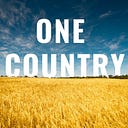Rural America is Not Benefiting in Trump’s Economy
New Bureau of Economic Analysis (BEA) Income Data Shows Rural Counties Bearing the Brunt of Trump’s Failed Economic Policy
The One Country Project (OCP), in an analysis of newly released BEA real personal income data, found that though real personal income grew nationally by 2.6 percent in 2017, agricultural states like Nebraska, Illinois, and Indiana all fell behind.
This week, news has started pouring in showing that rural America is getting fed up with the President’s misguided trade policies. These numbers are the start of what OCP believes is a peeling away of rural voters. Virgil Murray, an Iowan who voted for President Trump and is now open to voting for a Democratic candidate, told Reuters: “A lot of farmers voted for Trump. Now they’re feeling it.”
Pairing those anecdotal pieces with real data, we can see a path forward for Democrats.
For example, the five states with the slowest personal income growth were: North Dakota, South Dakota, Iowa, New Mexico, and Kansas. Further, 49 of the top 50 counties that experienced the biggest decreases in per capita personal income in 2017 were rural.
What do these numbers really mean? That the economy for Trump isn’t as strong as national numbers would lead him to believe and we would guess when updated numbers for 2018 are released they will mirror this same story.
Bottom line — Trump has been failing rural America for a while and the cracks are starting to show. These numbers, on top of increasing reports that rural Americans are feeling like collateral damage in the Trump trade war make it no mystery why “the patience of American farmers has worn very thin.”
More details from the BEA reports include:
§ The real personal income nationally grew 2.6 percent in 2017, an increase from 1.5 percent. However, despite this national growth, a large swathe of the American heartland is being left behind.
§ The five states with the slowest growth were: North Dakota and South Dakota (both suffering significant drops in real personal income year-over-year) and Iowa, New Mexico, and Kansas (which saw less than 1 percent growth in real personal income). (Source: BEA)
§ States classified by the U.S. Department of Agriculture (USDA) as the top ten agricultural producers all experienced average or below average income growth in 2017.
§ In a separate study, 49 of the top 50 counties that experienced the most significant decreases in per capita personal income in 2017 were classified as rural counties by the USDA. Significant drops in per capital personal income range from 8.5 percent to over 40 percent. (Source: BEA)
§ The enclosed map illustrates the economic division which has persisted between more urban states and their rural counterparts, with states in the Midwest, Great Plains, and Southern United States faring worse than others.
